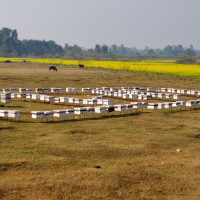- Monday, 15 December 2025
Rabies prevention limited to rhetoric
Kathmandu, Oct. 2:On September 28, concerned stakeholders in Nepal celebrated the World Rabies Day with the theme "All for 1, One Health for All" stating that the government prioritised prevention efforts against rabies. However, data on cases of dog bites shows that the issue has been on priority only in words.
According to the Epidemiology and Disease Control Division (EDCD), 117,861 cases of animal bites were reported in the fiscal year 2022/23. Of them, 106,993 were dog bite cases.
"If we look at the data on humans bitten by rabid animals (dogs, jackals, wolves, mongooses and cats among others), dog bites account for more than 90 per cent of the bite incidents. Of the 85,483 cases of animal bites in 2021/22, dogs were involved in 75,562 cases," said Dr. Hemanta Chandra Ojha, chief of the Zoonotic and Other Communicable Disease Control Section under the EDCD.
A comparison of the data on dog bites on an annual basis also shows that the cases have been soaring despite the government's assurance of taking the issue seriously.
As per the data, 54,996 cases of dog bites were reported in 2020/21; 52,610 in 2019/20; 32,882 in 2018/19; 33,204 in 2017/18; 37,226 in 2016/17; 20,133 in 2015/16; 17,320 in 2014/15 and 31,976 in 2013/14. On the other hand, while it is assumed that at least 100 individuals die of rabies in Nepal annually, only around 20 deaths on average are reported.
"If an individual is not vaccinated against rabies before s/he shows the symptoms of rabies, it is difficult to save him/her. Symptoms of rabies are seen when the virus has completely infected the individual. Nepalis often keep a rabies-infected individual in closed rooms after they find out that s/he cannot be saved," Dr. Ojha added.
However, the Department of Health Services (DoHS) states that despite rabies cases being almost fatal, it is 100 per cent preventable by vaccination, and awareness about human and animal interaction.
"Yearly, around 300,000 vials of rabies vaccine are administered to individuals bitten by rabid animals, mostly dogs, throughout the country.
Rabies vaccines are available in the majority of government health centres for free. It should, however, be administered only after proper consultation and examination by doctors,"
said Dr. Ojha.
"Many believe that small dogs do not transmit rabies, it is wrong. Sometimes rabies can spread from other than biting as well. It is necessary to be cautious while coming in contact with a strange dog," Dr. Ojha added.
A manual on rabies by the EDCD states that rabies can be transmitted to humans while touching or feeding animals, animals' licking on intact skin, nibbling of uncovered skin, minor scratches or abrasions without bleeding, single or multiple transdermal bites/scratches or contamination of mucous membrane or broken skin with saliva from animal licks, among others.
Doctors and veterinarians informed that the rabies vaccines for humans and animals are different. While Nepal produces rabies vaccines for animals, those for humans are procured through bidding by the government and are imported as necessary by private health centres.
Nevertheless, government health centres struggling with a lack of rabies vaccines still make news headlines.
In the first week of September, Bhim Hospital, a provincial hospital of Lumbini in Bhairahawa, had reported a lack of rabies vaccines.
"On average, 30 individuals with dog bites arrive in the hospital daily. Sometimes, the number rises up to 100. We are forced to send the victims to other health centres as we do not have enough vaccines in stock always," said Dr. Nurul Hoda, medical superintendent at the hospital. Dr. Hoda informed that the supply of rabies vaccines started dwindling three months ago and the hospital received 280 vials in mid-August as the last supply.
Preventing rabies in animals
Health experts stressed that rabies in humans cannot be prevented unless the pets, community and stray dogs are vaccinated against rabies annually.
"It has been accepted globally and scientifically that vaccinating 70 per cent of dogs against rabies helps break the rabies transmission cycle in an area at risk," said Dr. Sujan Rana, a senior veterinarian at the Department of Livestock Services (DoLS).
Dr. Rana, who is also the chief of the One Health Section at the DoLS, said that stakeholders assume Nepal has 2.9 million dogs. "We have to vaccinate over 2 million dogs to break the chain of rabies as per the necessary standard. However, we produce enough vaccines for only six per cent of the total dogs," added Dr. Rana.
Nepal's Central Veterinary Laboratory produces rabies vaccines for animals. "There have been upgrades in rabies vaccines over the years. Rabies vaccines have been produced in Nepal since the 1980s. Now, only rabies vaccines for animals are produced," said Dr. Rana.
According to the DoLS, the laboratory produces 180,000 vials of rabies vaccines annually. Of them, 90,000 vials are sold, 45,000 are kept for use on World Rabies Day, and the remaining 45,000 are kept in stock to distribute during rabies outbreak.
"The MRP for a vial of the vaccine sold by us is Rs. 55, which is the price set years ago. Similar vaccines cost over Rs. 100 outside. After much lobbying, the government has also allocated Rs. 20 million as a conditional grant for over 100 local levels, mostly in the Tarai, from this fiscal year to procure rabies vaccines for animals during emergency situations," said Dr. Rana.
While data shows a rapid rise in dog bite cases, experts have also pointed out the need to sterilise stray dogs to reduce their population.
"It is also necessary to prevent littering as it provides food for stray dogs everywhere leading to a rise in their population," said Dr. Rana.
Nevertheless, experts argue that vaccinating dogs and other animals prone to rabies is the best way.
"Local governments should be able to keep track of stray and community dogs and vaccinate them annually. They should also analyse if the vaccine was working or not. There is a need for effective coordination among all the stakeholders," said Dr. Rana.
















